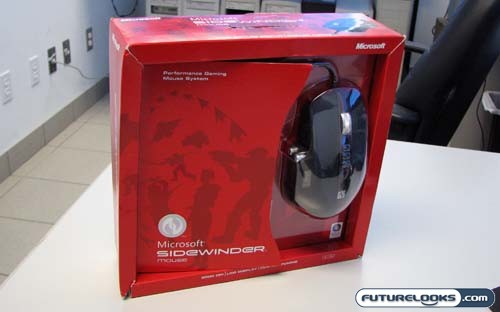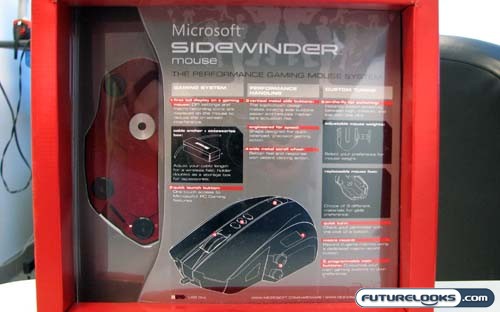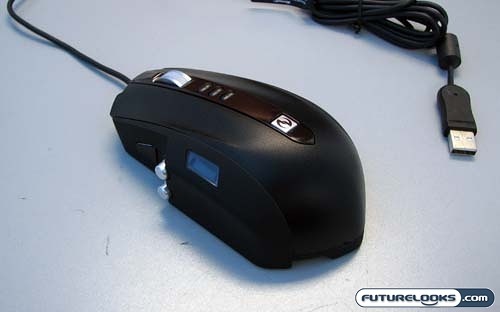Those who have been around gaming for a while will remember the venerable line of Sidewinder gaming peripherals from Microsoft. This product line started with a well known gamepad, and expanded into joysticks, more gamepads, and other purpose-built peripherals. These peripherals enjoyed varied success, and either by design or demand were retired by Microsoft in 2003.

Though some may argue this, the Sidewinder line was one of the fore-fathers of the modern gaming peripheral market. Back in the halcyon days of the mid to late nineties, Microsoft was one of only two players able to bring to market successful "gaming" peripherals. I use quotes because the gamer market wasn’t much more than a blip on the radar those short few years ago. The only other manufacturer of peripherals targeted at gamers that was well known in the mainstream was Logitech.
The times have certainly changed. Now in 2008 you can’t sneeze without some of your nasal discharge hitting a "gaming" targeted product. It is into this environment that Microsoft has decided to re-launch the Sidewinder brand. At the head of this charge is their new gaming mouse, which is simply called the Sidewinder Mouse.

The Microsoft Sidewinder mouse is made for gamers. It sports features seen in many other so called performance mice, including adjustable weighs, switch on the fly DPI settings, and multiple programmable buttons. The mouse is wired, which is peculiar in this age of wireless…everything. There has been rumblings that this is due to concerns over performance lag experienced in wireless mice by professional gamers. Since Microsoft is quite adamantly trying to target that market – and their followers by proxy – out goes the wireless transmitter in favour of a good ol’ USB cable.
Now performance lag is something I have not experienced in a wireless mouse since about 2003, but it does shave some money off the price tag. On the street this mouse can be had for about $80 USD, which places it below the $100 mark set by the Logitech G9 and above the Logitech G5 sticker price of $50. So after all these years on the sidelines, we now get to see if Microsoft and their new Sidewinder Mouse can cut it.
The Mouse

Upon un-boxing, the Microsoft Sidewinder Mouse definitely catches your eye in a couple of ways. The first thing I noticed was how large it looked. Granted it’s the same length and height as the Logitech G5 I mentioned earlier, but due to it’s sharp angles and high back it just looks much more bulky. As for the design, the mixture of black, dark red, and silver just screams "trying to look futuristic over here" in an attitude riddled New York accent. Microsoft’s team of designers definitely tried to make this device look at home next to a flashy case and keyboard. The looks are definitely subjective; some will like them while others will find them rather garish.
Real-Time Price and Stock Check – Shop Like a PRO!
While beauty may be in the eye of the beholder with this mouse, there’s no doubt the button layout is useful and practical. Rather than the usual rubber coated plastic, Microsoft employed a metal scroll wheel with grip etched in. They also used the more desirable "clicky" scrolling action, instead of the smooth scrolling found on so many of their mice. The former style of scrolling gives some tactile feedback when scrolling through weapons. This allows you to select your various implements of destruction one at a time, rather than flying through them like the latter form of scrolling causes.
The three buttons below the scroll wheel are for DPI selection, which affect the sensitivity of the laser sensor and in turn how fast or accurately your cursor moves. Each button is programmable with a different DPI level, and pressing a button instantly switches the mouse to that resolution. The defaults modes are, from top to bottom, 400, 800, and 2000 DPI. Now this whole setup is preferable to the plus and minus buttons found on most gaming mice. Rather than having to waste valuable time scrolling through DPI settings, you can go from headshot accuracy to full movement in a matter of seconds.
Now it should be clear by now that this mouse is not ambidextrous, and is meant to be used with your right hand. With that in mind I direct you to the left side of the Sidewinder Mouse, where your thumb would rest. Here you’ll find two silver buttons and a small black button. You’ll also find a first on a gaming mouse; and LCD display that shows in numbers the DPI level of the sensor. Forward of that are the two silver back and forward buttons, which are made of the same metal used for the scroll wheel. They are of course fully programmable.
Thanks to the design of the Sidewinder Mouse, the final button is rather difficult to reach without moving your entire hand. Luckily it’s only used for programming macros on the fly. Once pressed, you can record a macro of button combinations, and later use that macro to execute a spell in an MMO game or some feat of acrobatic destruction in an FPS game.
On the right side of the Microsoft Sidewinder Mouse you’ll find what at first appears to be nothing. However with a quick push on the button on the bottom, the cradle for the included weights pops out. Here you can insert up to 30 grams of weight, in 5 gram increments. This gives you full customizability should you want a heavy mouse that makes in presence in your hand obvious, or something with a more subtle touch.
Real-Time Price and Stock Check – Shop Like a PRO!
Once plugged in, the Sidewinder Mouse lights up in quite the fashion. The DPI buttons illuminate based on which settings is selected, and the LCD displaying that setting is fully backlit. Just to add to the bling factor, Microsoft added an LED on the bottom and pointed it out the rear of the mouse. This gives an effect some have described as looking like a jet engine. Hopefully it performs in a similar fashion.
The Accessories
Along with the Sidewinder Mouse, Microsoft has included a host of accessories that are best suited to this wired gaming rodent. In a small black (and notably heavier than it should be) rubberized case there were the afore mentioned weights, as well as different replacement feet for the bottom of the mouse. Of the weights, there are three 10g and one 5g. This gives you the option of setting a weight for the mouse of between 5g and 30g, in 5g increments. As for the replacement feet, each set is coated differently to affect how much they slip across your mousing surface.
The box itself is weighted, and is actually meant to double as a cable holder. There’s a slot to route the cable through, and it’s held in place to prevent tangling and maintain enough slack to allow you move around freely.
The Setup
Once you select the weight of your Microsoft Sidewinder Mouse, and pick the set of feet you want to use, you are ready to connect everything and install the software. Microsoft’s guide is rather helpful and concise, but they didn’t include any type of software CD. To fully utilize the Sidewinder, you need to download Intellipoint from Microsoft’s download site. On the bright side, this will ensure that you always have the latest version. On the downside, those unfortunate enough to not have Internet (they do still exist) can get the full benefits of the Sidewinder. The mouse still works, but it loses its programmability.
As mentioned, Microsoft uses only their standard Intellipoint software with the Sidewinder Mouse. There are of course features in the software that are specific to the Sidewinder. From the applet you can do the usual like changing mouse rates and button settings, but you can also select which buttons have which DPI settings. There’s also a built in macro editor that works in concert with the mentioned macro button. You can create new macros from here, as well as edit the ones that have been recorded on the fly.
Real-Time Price and Stock Check – Shop Like a PRO!
The Handling and Gameplay
The reason I’m brandishing my hairy, scary forearm here is to talk about the handling and feel of this mouse. In their design of the Sidewinder Mouse, Microsoft has followed the trend in gaming mice and made their device rather large. The device is no bigger in length and height than my beloved Logitech MX1000 (a mouse I should probably admit to considering perfect), but the Sidewinder feels…different. It just feels…well…big. Big like the first generation Xbox controllers that only Shaquille O’Neal could love and why it sucked in Japan because no one could use them.
Where as the Logitech MX1000 (and by extension the G5, G7, and MX518 which are all based off the MX1000 design) lets my hand rest on the mouse, the Microsoft Sidewinder has my hand just cupping and palming the mouse. This is most likely due to Microsoft’s design decision to place the high point of the mouse near the back rather than in the centre like Logitech. I didn’t find it very comfortable. The closest I could describe it was like handling clay that was cold and without any pliability. Due to my hand position I found my fingers weren’t as relaxed on the buttons; they were more in a "claw" shape.
First off I loaded up a rather well known FPS game; Call of Duty 4. The game is nice way to ease into testing, as the movements in it are very intentional and controlled. The game does border on the tactical shooter genre in single player. In this environment, the adjustable DPI and extra-sensitive laser sensor both shined. I was able to draw a bead on the enemy easily, and neutralize them quickly.
Though I did enjoy my game play in CoD4, I still found the mouse uncomfortable. I did get used to it, but it always made it’s presence known. Compared to a similar amount of game play with my Logitech MX1000, the Sidewinder just felt a little ham-fisted. With all that in mind, I decided to move on to what is easily my favourite FPS game of 2007.
Team Fortress 2 is a bit of a different animal than Call of Duty 4. Where as the movement and combat in CoD4 are much more intentional and controlled, the same aspects in TF2 are very frantic and kinetic. In combat I found the adjustable DPI invaluable. Since TF2 is a class based first person shooter, you’ll be wearing many hats and will be expected to adjust to a constantly changing battlefield. As a sniper I was able to change to a low DPI setting to further enhance my accuracy when scoped, and should any spies try any funny business I could switch to a higher DPI and my Machete very quickly and cleave the offender in two. Dudey! As for the swappable feet, they seemed to help out with the Scout class. With these accessories, I could increase the amount of friction in the movement of the Sidewinder. This allowed me to smooth out the Scout’s ultra fast movement, and made my scatter-gun something to be feared.
As for the experience itself, I played a good 2 hour session and my impressions of the Sidewinder Mouse turned out worse than with the time spent playing CoD4. Though the movement was fluid, the mouse was once again very uncomfortable. After an hour of playtime, I had to take a 15 minute break to let the pain in my hand and wrist subside. This is something I’ve never experienced with my MX1000, and I’ve had it in so many environments. This is most likely due to the afore mentioned design elements of the Sidewinder Mouse. It’s high point causes you to have to cup your hand around the mouse, and more of your wrist on the mousing surface.
Admittedly some gamers out there will like the design, and find it very useful. As for me, I’ll be holding onto my Logitech MX1000 until one of us croaks. With what I experienced in mind, I think it’s time for me to wrap this review up.
Real-Time Price and Stock Check – Shop Like a PRO!
The Conclusion
The Microsoft Sidewinder Mouse is definitely an interesting encore performance. It marks Microsoft’s attempt to return to the forefront on the gaming peripheral market. At the very least, it makes for a surprise reunion tour after we all thought the Sidewinder line had sang its swan song. I’m still left wondering if Microsoft really knows what they are getting into, as this time around there are many more players in the gaming peripherals market. We’ll have to wait and see.
As for the Microsoft Sidewinder Mouse itself, it’s hard to deny that it is a feature rich mouse. The laser sensor is quite sensitive and accurate. There is no perceived performance lag, if such a thing exists in the modern optical mouse environment. Finally the mouse is fully customizable in both feel and functionality.
The feel and functionality of the Sidewinder is also its one failing point, if not at the very least a major caveat. Though some may like the design, the fact that it caused me physical pain is not something I take lightly. The size of this mouse is just too big, and its ergonomics don’t seem to be very well thought out.
The fit will appeal to some gamers, as everyone does have different comfort preferences. Some will still prefer the shape of the Logitech G5, while others with find the Sidewinder to be the answer to their quest for the perfect mouse. I’m in in the former camp, as I found the Sidewinder mouse to feel like a lump of clay in my hand. Your mileage may of course vary. Even after getting used to the feel of the mouse, I still found it uncomfortable.
The functionality was overall very feature rich, but it has its questionable options as well. The main one would be the macro controls, which while being a great idea are also kinda impeded by the fact that your macro has to be mapped to one of the mouse buttons. You then loose default functionality for this button.
In the end, it’s hard for me to give a reward to a product that has actually cause me physical pain. Luckily we are just talking about a hand cramp, and I’m a tough guy, but if I experienced this problem, I’m sure someone else undoubtedly will, and it will affect their gaming experience in a big way. On technical merit alone I would award Microsoft an 8 rating, but due to the points I’ve mentioned here I must knock down a point and place a wrist health warning on it. It definitely looks interesting, and has some awesome features, but the fit is what will make or break your enjoyment of this product. Try before you buy.
The Good
- Smooth accurate movement
- Adjustable DPI that’s quick to access
- Fully customizable feel and functionality
The Bad
- Looks may seem garish to some
- Feels uncomfortable and ham-fisted
- Hand cramps and pain in fast moving games
- Needs to be tried out before being bought
Overall Rating: 7.0 / 10.0
Discuss This Review in the Futurelooks Community Forums
Real-Time Price and Stock Check – Shop Like a PRO!
